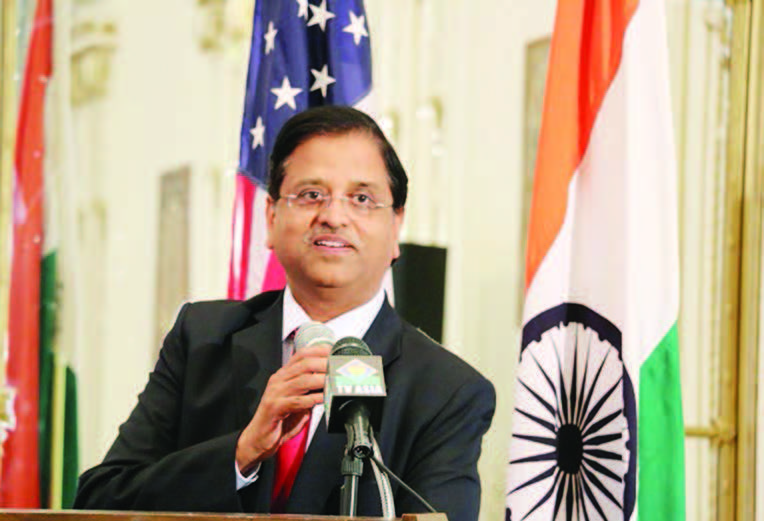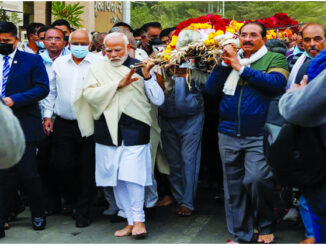
WASHINGTON, D.C. (TIP): India‘s drone industry has “leapfrogged” in the last 10 years, gaining pace after the COVID-19 pandemic, the CEO of a leading Indian drone manufacturer has said as his company has showcased its products in the highly competitive US market. Indian drone manufacturing company IdeaForge, ranked fifth globally in the dual-use category of civil and defense, is entering the American drone market at a time when there is a reluctance to buy or acquire those made in China.
Ankit Mehta, the CEO of IdeaForge, told PTI Videos in an interview that the Indian drone industry has “leapfrogged in the last 10 years with an enabling environment from the Indian government.” He said the sector gained pace after the COVID-19 pandemic.
“I think before the pandemic, the rules and regulations around drones were fairly stringent, and they did not allow a lot of flexibility in terms of use and deployment,” Mehta said.
“But since the pandemic, the floodgates, in a way, have opened the adoption of technology, which has become wholehearted. Now people want to deploy drones for as many use cases as possible,” he said.
Drones had very restrictive regulations earlier, he said. “Now those regulations have become a little bit more relaxed in terms of allowing the use of drones under a regulated environment, which is conducive for operations.”
“Therefore, we are seeing a lot of intent in terms of adopting the technology, and we are seeing a lot of regulatory support for doing that,” Mehta said.
“We also have in India a production-linked incentive scheme for drones. We have the fact that there is a ban on import of technology from outside so that Indian companies can develop the technology and be overall in an environment where we can demonstrate the capability of what Indian companies can do in this space,” he said.
Asserting the distinctiveness of Indian drones, he said, “I think Indian drones are very unique in the sense that they’ve been built in some of the harshest environments and the highest altitude requirements in the world.”
“With the operations being conducted in India at 6,000 meters plus altitude due to the various regions we have in our country in the Himalayas, to operate in extremely low temperatures like minus 30 degrees Celsius and also looking at drones that can operate in deserts in Rajasthan,” he said.
“So, we are essentially a country that has a very large number of terrain conditions and weather conditions we have to cater to when we are looking at drones. We also have a lot of use cases and applications that exist simultaneously in one place,” he said.
Giving examples of applications around traffic management, crowd management, counterinsurgency, counter-terrorism, and border management Mehta said, “All of these challenges are quite acute, and there are a lot of challenges around not having proper land records, and many such applications are being developed in India, and they’re being used and deployed at scale.”
Mehta is travelling to various cities in the US for product demonstrations to export different kinds of drones to the country. One of which was held in the Washington DC National Capital region here on Thursday.
“We are seeing a lot of excitement about what we have on offer. The autonomy we offer again is very, very interesting and exciting for people, and we are currently engaging in getting as many demonstrations as we can and getting more real-world experience in the hands of the users over here. So that can localize our products better as well as give a flavor of our technology to everybody here,” Mehta told PTI.
“For example, one of our products, Netra V 4 Pro, is a one-of-a-kind product that, in less than six kilograms, offers more than 90 minutes of flying time in the real world along with payloads. That is something that is not very common,” he said.
“It is almost three times more than what is usually available in the market. In that sense, there is a lot of delight in when they actually see a product perform in that kind of condition, in that kind of real-world performance,” he added.
Following one of the product demonstrations here, along with his team, Mehta said the idea is to showcase their technology over here and to look at what kind of uses the technology can put over here.
IdeaForge, set up in 2007 by a group of Mumbai IITians , can bring the experience they are gaining in India, he said. “We have had our customers use our drones in over 420,000 missions within IdeaForge drones, flying almost every five minutes in India,” he said.
“It’s really a rich experience that we can bring to the table here, and we see a lot of commonalities with respect to very low temperatures, very high temperatures, and some high-altitude areas over here as well,” Mehta said.
“What we are building here to deploy at scale in India could be very, very useful in these environments as well,” he added. When asked about India purchasing armed drones from General Atomics for its armed forces at the cost of nearly USD 4 billion, Mehta said it would need sustained long-term investment from relevant sectors, including the Indian Government, to reach that level of manufacturing such drones.
“Manpower is definitely not a debate because India does have some of the best talent. In fact, a lot of our best talent is here building a lot of these technologies,” Mehta said. Observing that the government has done a great job building the proper regulations for the drone ecosystem, Mehta said there is now a need to sustain these investments in areas like the production-linked incentive scheme.
“We need to enhance it, and we need to give more encouragement. It is a one-of-a-kind scheme that does a lot of support to design incentives for drone companies because, in a way, it gives a lot of R and D (research and development) capital back to every company that is doing more value addition in the country,” he said.
“A lot of upfront R and D capital needs to be allocated for this technology space, and that’s an area where some effort and support will be required for the drone ecosystem because a lot of times, incentives like the production-linked incentive are great to boost scale and to do more for players who are already achieved a certain scale,” he said.
However, Mehta said that a lot of R and D capital for designing many subsystems in the country would be very useful for the overall benefit and development of the ecosystem.
(Source: PTI)





Be the first to comment